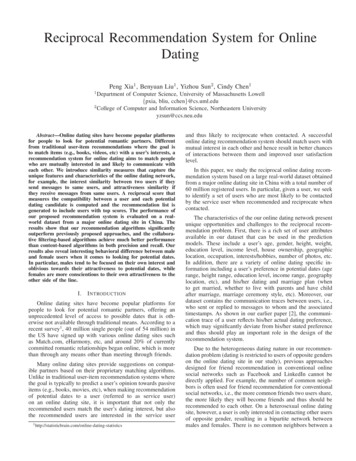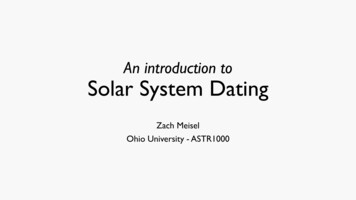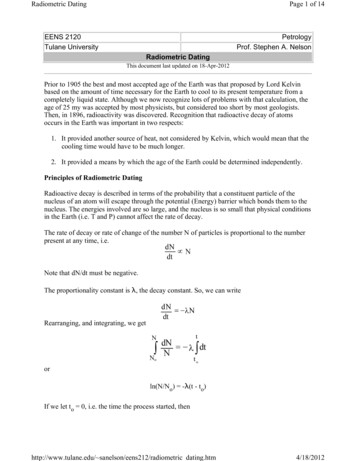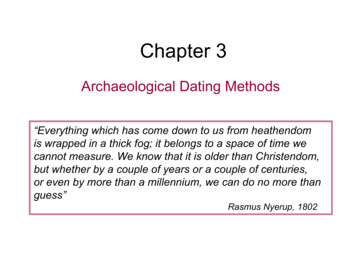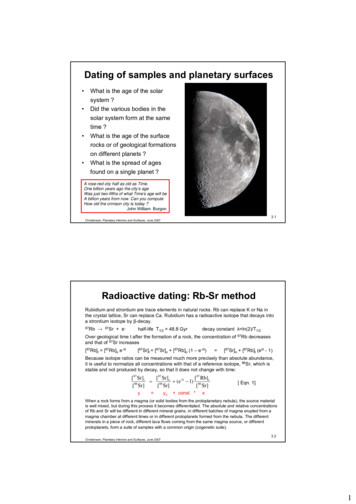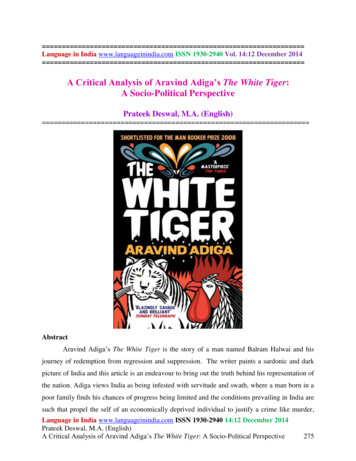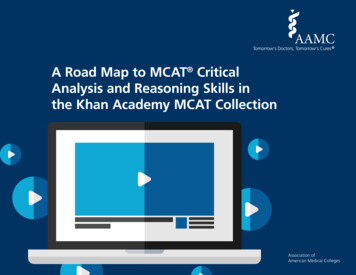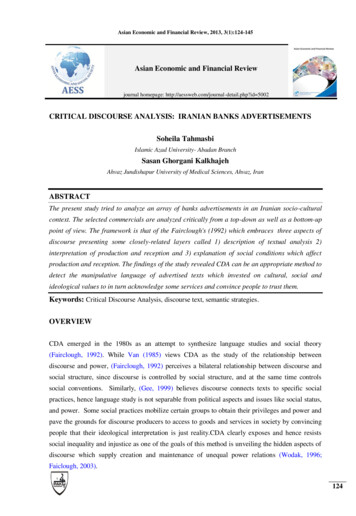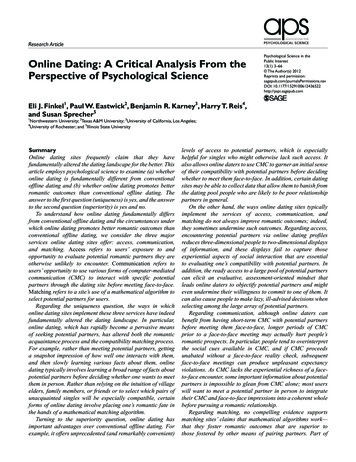
Transcription
XXX10.1177/1529100612436522Finkel et al.Online Dating2012Research ArticleOnline Dating: A Critical Analysis From thePerspective of Psychological SciencePsychological Science in thePublic Interest13(1) 3 –66 The Author(s) 2012Reprints and permission:sagepub.com/journalsPermissions.navDOI: 10.1177/1529100612436522http://pspi.sagepub.comEli J. Finkel1, Paul W. Eastwick2, Benjamin R. Karney3, Harry T. Reis4,and Susan Sprecher51Northwestern University; 2Texas A&M University; 3University of California, Los Angeles;University of Rochester; and 5Illinois State University4SummaryOnline dating sites frequently claim that they havefundamentally altered the dating landscape for the better. Thisarticle employs psychological science to examine (a) whetheronline dating is fundamentally different from conventionaloffline dating and (b) whether online dating promotes betterromantic outcomes than conventional offline dating. Theanswer to the first question (uniqueness) is yes, and the answerto the second question (superiority) is yes and no.To understand how online dating fundamentally differsfrom conventional offline dating and the circumstances underwhich online dating promotes better romantic outcomes thanconventional offline dating, we consider the three majorservices online dating sites offer: access, communication,and matching. Access refers to users’ exposure to andopportunity to evaluate potential romantic partners they areotherwise unlikely to encounter. Communication refers tousers’ opportunity to use various forms of computer-mediatedcommunication (CMC) to interact with specific potentialpartners through the dating site before meeting face-to-face.Matching refers to a site’s use of a mathematical algorithm toselect potential partners for users.Regarding the uniqueness question, the ways in whichonline dating sites implement these three services have indeedfundamentally altered the dating landscape. In particular,online dating, which has rapidly become a pervasive meansof seeking potential partners, has altered both the romanticacquaintance process and the compatibility matching process.For example, rather than meeting potential partners, gettinga snapshot impression of how well one interacts with them,and then slowly learning various facts about them, onlinedating typically involves learning a broad range of facts aboutpotential partners before deciding whether one wants to meetthem in person. Rather than relying on the intuition of villageelders, family members, or friends or to select which pairs ofunacquainted singles will be especially compatible, certainforms of online dating involve placing one’s romantic fate inthe hands of a mathematical matching algorithm.Turning to the superiority question, online dating hasimportant advantages over conventional offline dating. Forexample, it offers unprecedented (and remarkably convenient)levels of access to potential partners, which is especiallyhelpful for singles who might otherwise lack such access. Italso allows online daters to use CMC to garner an initial senseof their compatibility with potential partners before decidingwhether to meet them face-to-face. In addition, certain datingsites may be able to collect data that allow them to banish fromthe dating pool people who are likely to be poor relationshippartners in general.On the other hand, the ways online dating sites typicallyimplement the services of access, communication, andmatching do not always improve romantic outcomes; indeed,they sometimes undermine such outcomes. Regarding access,encountering potential partners via online dating profilesreduces three-dimensional people to two-dimensional displaysof information, and these displays fail to capture thoseexperiential aspects of social interaction that are essentialto evaluating one’s compatibility with potential partners. Inaddition, the ready access to a large pool of potential partnerscan elicit an evaluative, assessment-oriented mindset thatleads online daters to objectify potential partners and mighteven undermine their willingness to commit to one of them. Itcan also cause people to make lazy, ill-advised decisions whenselecting among the large array of potential partners.Regarding communication, although online daters canbenefit from having short-term CMC with potential partnersbefore meeting them face-to-face, longer periods of CMCprior to a face-to-face meeting may actually hurt people’sromantic prospects. In particular, people tend to overinterpretthe social cues available in CMC, and if CMC proceedsunabated without a face-to-face reality check, subsequentface-to-face meetings can produce unpleasant expectancyviolations. As CMC lacks the experiential richness of a faceto-face encounter, some important information about potentialpartners is impossible to glean from CMC alone; most userswill want to meet a potential partner in person to integratetheir CMC and face-to-face impressions into a coherent wholebefore pursuing a romantic relationship.Regarding matching, no compelling evidence supportsmatching sites’ claims that mathematical algorithms work—that they foster romantic outcomes that are superior tothose fostered by other means of pairing partners. Part of
4the problem is that matching sites build their mathematicalalgorithms around principles—typically similarity but alsocomplementarity—that are much less important to relationshipwell-being than has long been assumed. In addition, these sitesare in a poor position to know how the two partners will growand mature over time, what life circumstances they will confrontand coping responses they will exhibit in the future, and howthe dynamics of their interaction will ultimately promote orundermine romantic attraction and long-term relationshipwell-being. As such, it is unlikely that any matching algorithmthat seeks to match two people based on information availablebefore they are aware of each other can account for more thana very small proportion of the variance in long-term romanticoutcomes, such as relationship satisfaction and stability.In short, online dating has radically altered the datinglandscape since its inception 15 to 20 years ago. Some of thechanges have improved romantic outcomes, but many havenot. We conclude by (a) discussing the implications of onlinedating for how people think about romantic relationships andfor homogamy (similarity of partners) in marriage and (b)offering recommendations for policymakers and for singlesseeking to make the most out of their online dating endeavors.IntroductionFor as long as humans have recognized the urge to form romanticrelationships, they have also recognized that finding an appropriate partner can be challenging, and that sometimes it is useful toget some help. From the Jewish shadchan immortalized in themusical Fiddler on the Roof, to the khastegari customs of Iran, tothe arranged marriages still prevalent in parts of Southeast Asia,there is a tradition—millennia old—of romantic relationshipsarising not only from chance encounters between two individualsbut also from the deliberate intervention of third parties (Coontz,2005). For most of those millennia, the resources available tothese third parties remained the same: a broad social network,strong opinions about the sorts of people who belong together,and the willingness to apply those judgments to the formation ofactual couples (Ahuvia & Adelman, 1992).In the modern age, the desire to find a romantic partnerendures, as does the sense that doing so can be challenging. Butthe resources available for meeting these challenges havechanged, and many of these changes can be traced to the invention, spread, and now ubiquity of the Internet. According to recentdata, some 30% of the 7 billion people on our planet now haveaccess to the Internet (InternetWorldStats.com, 2011). In NorthAmerica, where Internet usage is highest, that figure reaches78%. Every domain of contemporary life, from commerce andpolitics to culture, is now touched by the Internet in some way.With respect to forming romantic relationships, the potential to reach out to nearly 2 billion other people offers severalopportunities to the relationship-seeker that are unprecedentedFinkel et al.in human history. First, whereas the “field of eligibles” (Kerckhoff, 1964) for an individual was once limited primarily tomembers of that individual’s social network, the Internet nowaffords access to a vastly wider network of potential partnerswho would have been unknown or inaccessible in former eras.Second, whereas interaction between potential partners oncedepended on their proximity to each other, the Internet nowfacilitates nearly instantaneous communication via multiplechannels (i.e., text, voice, image, and video) without partnershaving to be in the same location and even without partners’conscious awareness (e.g., by allowing others to view one’sinformation online). Third, whereas the choice of a mate oncerelied largely upon the individual’s intuitions and personalopinions, the Internet promises to create matches betweensuitable partners using new tools that draw upon data providedby thousands, or millions, of users.Recognizing the unique possibilities afforded by the Internet, numerous commercial Web sites have arisen to providethese services to users seeking romantic relationships. Specifically, the past 15 to 20 years have witnessed the developmentof Web-based companies that specialize in providing somecombination of:a. access to potential romantic partnersb. communication with potential romantic partnersc. matching with compatible romantic partners.Each year, millions of hopeful relationship seekers use thesesites, often paying substantial fees for the privilege.To attract customers, online dating sites typically emphasize two aspects of the services they offer. First, they emphasize that their services are unique to dating through theInternet; that is, the sites are offering a service that cannot beduplicated in any other way. The homepage of PlentyOfFish,for example, claims that membership on the site gets youaccess to “145 million monthly visitors” and that “you are notgoing to find any other site that has more singles looking tomeet new people” (PlentyOfFish.com, 2011). Presumably thatclaim refers not only to other Web sites but also to other venues where single people gather to meet, such as bars, parties,churches, or libraries. Second, online dating sites emphasizethat forming relationships using their services is superior todating offline. The Web site for eHarmony, for example,asserts that the services the site offers “deliver more than justdates”; instead, it promises connections to “singles who havebeen prescreened on . . . scientific predictors of relationshipsuccess” (eHarmony.com, 2011b, para. 1). The implication isthat eHarmony possesses knowledge about relationships thatmost people lack and that applying this knowledge will lead tomore favorable relationships than subscribers would experience without this knowledge. The OkCupid Website alsoimplies access to knowledge unavailable to the layperson withCorresponding Author:Eli J. Finkel, Northwestern University, 2029 Sheridan Road, Swift Hall #102, Evanston, IL 60208-2710E-mail: finkel@northwestern.edu
Online Datingthe straightforward claim, “We use math to get you dates”(OkCupid.com, 2011). By referring to millions of users, science, and math, online dating sites suggest that meetingromantic partners online is not only different from, but alsobetter than, searching for partners in conventional ways.Each of these claims raises questions that can be answeredempirically. For example, with respect to uniqueness, does therise of online dating represent a fundamental change in theprocess of forming and maintaining romantic relationships?With respect to superiority, are the users of online dating sitesin fact improving their chances of experiencing positiveromantic outcomes compared to individuals who rely entirelyon more conventional methods of meeting partners?Addressing such questions is of great public importance forseveral reasons. First, romantic relationships—their presence,as well as success or failure—play a central role in individuals’ physical and emotional well-being. The need to connectdeeply with others has been described as a “fundamentalhuman motivation” (Baumeister & Leary, 1995). When thatneed is fulfilled by a satisfying intimate relationship, couplesexperience better health (Cohen et al., 1998), recover from illnesses more quickly (Kiecolt-Glaser et al., 2005), and live longer (Gallo, Troxel, Matthews, & Kuller, 2003; Holt-Lunstad,Smith, & Layton, 2010). Indeed, the presence of a satisfyingintimate relationship is one of the strongest predictors of happiness and emotional well-being that has been measured (Diener & Seligman, 2002). Loneliness and distressed relationships,in contrast, predict increased risks of depression and illness(Cacioppo et al., 2002) and incur enormous national costs interms of lost productivity (Forthofer, Markman, Cox, Stanley, &Kessler, 1996), and they are the leading reasons why peopleseek therapy or help from lay counselors in the United States(Veroff, Kulka, & Douvan, 1981). Thus, online dating sites aretreading in deep waters, and whatever the implications of thesesites, those implications are likely to have strong ripple effects.Second, as commercial dating sites become increasinglyaccepted as a means of forming romantic relationships, moreand more couples are meeting online (Rosenfeld, 2010). Oneindustry trade report estimated that almost 25 million uniqueusers around the world accessed an online dating site in April,2011 alone (Subscription Site Insider, 2011). If some of theindividuals who form relationships online would not otherwise have found partners, then the availability of the uniqueservices that the Internet provides may be a boon to relationship seekers. Moreover, if relationships formed through theInternet are in fact superior to
online dating is fundamentally different from conventional offline dating and (b) whether online dating promotes better romantic outcomes than conventional offline dating. The answer to the first question (uniqueness) is yes, and the answer to the second question (superiority) is yes and no. To understand how online dating fundamentally differs
